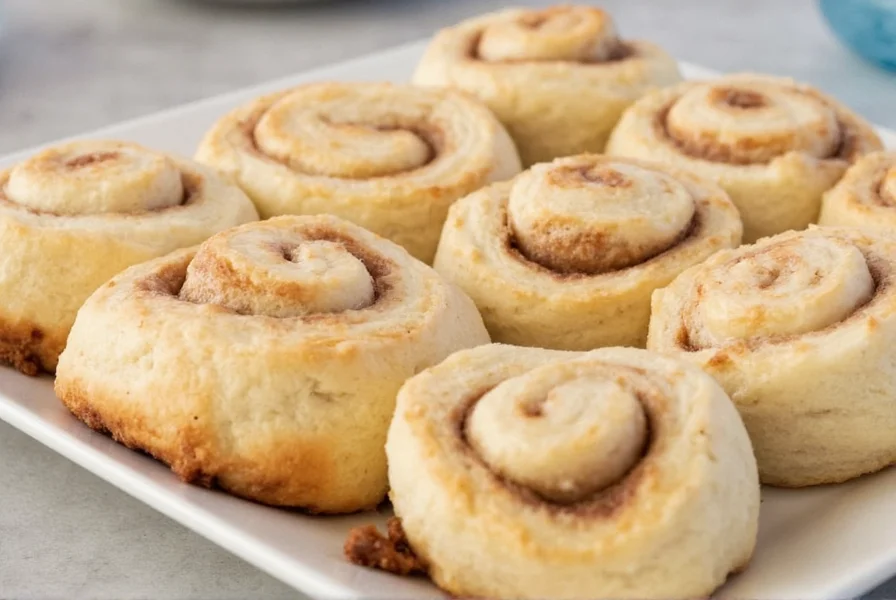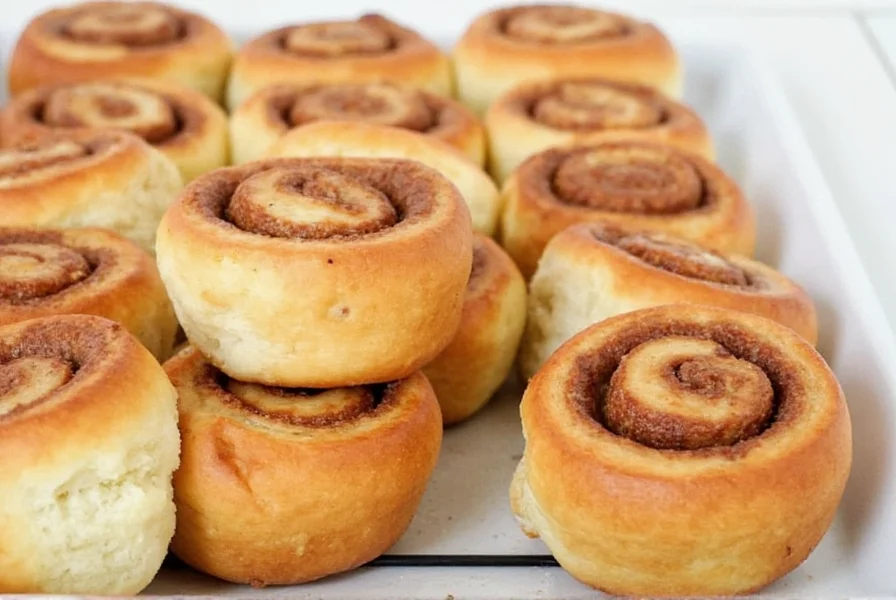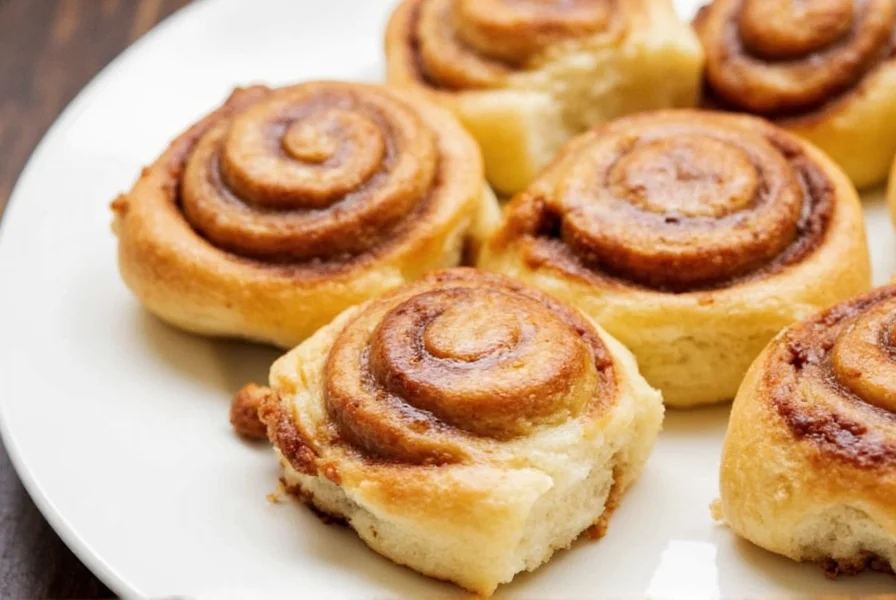The best homemade cinnamon rolls recipe features a soft, fluffy yeast dough with a rich cinnamon-sugar filling and creamy cream cheese icing. This from-scratch recipe yields perfectly golden rolls with a tender crumb in about 3 hours total time, including rising. Key to success: use lukewarm milk (110°F/43°C), activate yeast properly, and don't overbake—remove when centers reach 190°F (88°C).
There's nothing quite like the aroma of freshly baked cinnamon rolls filling your kitchen. This classic recipe has been perfected through decades of baking experience, delivering consistently soft, pillowy rolls with just the right balance of sweet and spice. Unlike many shortcuts that compromise texture, this method uses a simple yeast dough that develops incredible flavor through proper fermentation.
Why This Cinnamon Roll Recipe Works
What sets this best homemade cinnamon rolls recipe apart is its attention to yeast management and dough hydration. The secret to achieving that signature melt-in-your-mouth texture lies in the milk-to-flour ratio and precise rising conditions. Many home bakers struggle with dense rolls, but our method ensures light, airy results every time by controlling fermentation temperature and avoiding common pitfalls like over-flouring during kneading.
Essential Ingredients Explained
Quality ingredients make the difference between good and great cinnamon rolls. Here's what you'll need and why each component matters:
| Ingredient | Amount | Why It Matters |
|---|---|---|
| Active dry yeast | 2¼ tsp (1 packet) | Fresh yeast ensures proper rise; test in warm liquid first |
| Whole milk | 1 cup, warmed | Fat content creates richer texture than skim milk |
| Unsalted butter | ⅓ cup, melted | Provides flavor and tender crumb; cool before adding |
| Granulated sugar | ½ cup + ¾ cup for filling | Feeds yeast and balances cinnamon's intensity |
| All-purpose flour | 3½-4 cups | Measure properly—spoon and level to avoid dense rolls |
| Ground cinnamon | 2 tbsp | Use Ceylon cinnamon for complex flavor, not just heat |
| Cream cheese | 4 oz, softened | Essential for authentic tangy-sweet icing |

Equipment Checklist
Having the right tools streamlines the easy cinnamon roll baking instructions process:
- Stand mixer with dough hook (or large bowl for hand mixing)
- Rolling pin
- 9x13 inch baking pan
- Instant-read thermometer (critical for perfect baking)
- Parchment paper or silicone mat
Step-by-Step Baking Instructions
Follow these detailed steps for soft and fluffy cinnamon roll dough that rises perfectly:
Dough Preparation (45 minutes)
- Activate yeast: Combine warm milk (110°F), 1 tbsp sugar, and yeast. Wait 5-10 minutes until foamy.
- Mix wet ingredients: Add melted butter, egg, and remaining sugar to yeast mixture.
- Combine dry ingredients: Whisk 3 cups flour, salt, and 1 tsp cinnamon in separate bowl.
- Knead dough: Mix wet and dry ingredients, adding remaining flour as needed until smooth ball forms (8-10 minutes in mixer).
- First rise: Place in greased bowl, cover, and let rise in warm spot until doubled (1-1½ hours).
Filling and Shaping (20 minutes)
- Prepare filling: Mix ¾ cup sugar and 2 tbsp cinnamon. Cut ⅓ cup cold butter into small cubes.
- Roll dough: Punch down risen dough and roll into 16x12 inch rectangle on floured surface.
- Add filling: Spread softened butter over dough, then sprinkle cinnamon-sugar mixture evenly.
- Roll tightly: Starting from long edge, roll dough into log. Pinch seam to seal.
- Cut rolls: Using dental floss (prevents squishing), cut log into 12 equal pieces.
Baking and Finishing (30 minutes)
- Second rise: Place rolls in greased baking dish, cover, and let rise 30-45 minutes until puffy.
- Bake: Preheat oven to 350°F (175°C). Bake 22-25 minutes until golden and internal temperature reaches 190°F (88°C).
- Cool slightly: Let rolls rest 10 minutes while preparing icing.
- Make icing: Beat 4 oz cream cheese, 2 tbsp butter, 1½ cups powdered sugar, and 1 tsp vanilla until smooth.
- Finish: Drizzle warm rolls with icing and serve immediately.

Troubleshooting Common Problems
Even experienced bakers encounter issues with classic cinnamon roll filling recipe execution. Here's how to fix them:
- Dense rolls: Usually caused by too much flour or old yeast. Measure flour by spooning into cup and leveling—don't scoop. Test yeast freshness before starting.
- Filling leaking out: Ensure butter is softened but not melted when spreading. Roll dough tightly and seal the edge well.
- Burnt bottoms: Place baking dish on a preheated baking sheet. Check oven temperature with separate thermometer.
- Rolls spreading sideways: Don't over-rise during second proofing. Rolls should be touching but not bulging excessively.
Storage and Reheating Tips
For optimal freshness with your perfect cinnamon roll icing recipe:
- Room temperature: Store covered for up to 2 days
- Refrigerator: Keep in airtight container for up to 5 days
- Freezer: Wrap individual rolls in plastic wrap, then foil. Freeze up to 3 months.
- Reheating: Microwave frozen roll 20-30 seconds, then warm in 300°F oven for 5 minutes for best texture
Popular Recipe Variations
Adapt this how to make cinnamon rolls from scratch foundation for different dietary needs:
- Vegan version: Substitute dairy milk with almond milk, use vegan butter, and replace egg with ¼ cup unsweetened applesauce
- Gluten-free: Use 1:1 gluten-free flour blend and add 1 tsp xanthan gum to dough
- Streusel topping: Mix ¼ cup flour, ¼ cup brown sugar, and 2 tbsp cold butter for crumbly topping
- Apple cinnamon rolls: Add ½ cup finely diced apples to filling mixture
Expert Baking Tips
Professional bakers rely on these techniques for cinnamon roll baking temperature guide perfection:
- Maintain consistent kitchen temperature (75-80°F) for ideal rising conditions
- Use an instant-read thermometer to verify milk temperature—critical for yeast activation
- When rolling dough, maintain even pressure to prevent thin spots
- For cleaner cuts, chill rolled log for 15 minutes before slicing
- Rotate baking pan halfway through baking for even browning
Frequently Asked Questions
How do I know when cinnamon rolls are done baking?
Cinnamon rolls are perfectly baked when they reach an internal temperature of 190°F (88°C) and the edges are golden brown. The center should spring back when lightly pressed. Overbaking causes dryness, so check 2 minutes before the minimum baking time.
Can I prepare cinnamon roll dough the night before?
Yes, you can refrigerate the shaped rolls after the second rise. Place them in the baking dish, cover tightly, and refrigerate for up to 18 hours. When ready to bake, remove from refrigerator and let sit at room temperature for 30 minutes while oven preheats.
Why did my cinnamon rolls come out dry?
Dry cinnamon rolls typically result from overbaking, too much flour in the dough, or old baking powder/soda if used. Measure flour correctly by spooning into measuring cups and leveling. Use an oven thermometer to verify temperature accuracy, and check rolls 2-3 minutes before the minimum baking time.
What's the best type of cinnamon to use for cinnamon rolls?
Ceylon cinnamon (often called 'true cinnamon') provides a more complex, less harsh flavor than common Cassia cinnamon. For best results, use a blend of both—2 parts Ceylon to 1 part Cassia—for balanced sweetness and warmth without bitterness.











 浙公网安备
33010002000092号
浙公网安备
33010002000092号 浙B2-20120091-4
浙B2-20120091-4